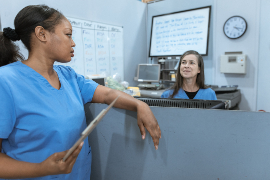Spotlights
Similar Titles
Clinic Office Assistant, Front Desk Receptionist, Medical Office Specialist, Medical Receptionist, Medical Secretary, Physician Office Specialist, Secretary, Unit Clerk, Unit Support Representative, Ward Clerk, Medical Biller
Job Description
Perform secretarial duties using specific knowledge of medical terminology and hospital, clinic, or laboratory procedures. Duties may include scheduling appointments, billing patients, and compiling and recording medical charts, reports, and correspondence.
The Inside Scoop
Job Responsibilities
- Answer telephones and direct calls to appropriate staff.
- Schedule and confirm patient diagnostic appointments, surgeries, or medical consultations.
- Complete insurance or other claim forms.
- Greet visitors, ascertain purpose of visit, and direct them to appropriate staff.
- Transmit correspondence or medical records by mail, e-mail, or fax.
Skills Needed on the Job
- Speaking — Talking to others to convey information effectively.
- Active Listening — Giving full attention to what other people are saying, taking time to understand the points being made, asking questions as appropriate, and not interrupting at inappropriate times.
- Service Orientation — Actively looking for ways to help people.
- Reading Comprehension — Understanding written sentences and paragraphs in work-related documents.
- Complex Problem Solving — Identifying complex problems and reviewing related information to develop and evaluate options and implement solutions.
Organization Types
- Offices of physicians
- Hospitals; state, local, and private
- Outpatient care centers
- Offices of chiropractors
Newsfeed

Featured Jobs

Online Courses and Tools







